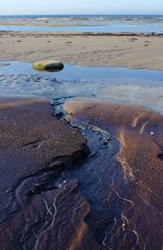Nitrate-bearing groundwater enters the sea
Nitrates used in intensive agriculture can be carried to the sea by streams and rivers. However, an unknown amount can seep into underlying groundwater and enter the marine environment through the shoreface or seabed. This may cause algal blooms, an explosion of algal growth which can lead to poorer water quality, a drop in species numbers and falling seafood production. The NAME project used thermal infrared aerial photography together with geophysical measurements to study the entry of groundwater into the sea. Detailed chemical analyses of the aquifer and the seabed were also carried out. The information collected was used to build and calibrate computer models for determining the flow of nitrates from groundwater into the marine environment. Researchers from the Danish company DHI Water & Environment carried out integrated 3D modelling of groundwater transport and marine ecosystems. The study site was at Ho Bay, in the Graadyb Estuary, in western Denmark. The groundwater in this area is affected by nitrate leaching and seeps directly into the sea. The model used was based on MIKE 3 FM software, which was previously developed by the company as a water resource management system. By comparing computer simulations with and without input of groundwater, researchers found that the effect of the nitrate was relatively small. This was due to the low level of the pollutant entering the estuary, which was then removed by the flushing effect of the tides. The project successfully brought together experts in groundwater and the marine environment, who gained a greater insight into the phenomena of nitrate cycling and groundwater movement. The end result promises to provide more sustainable coastal management.







